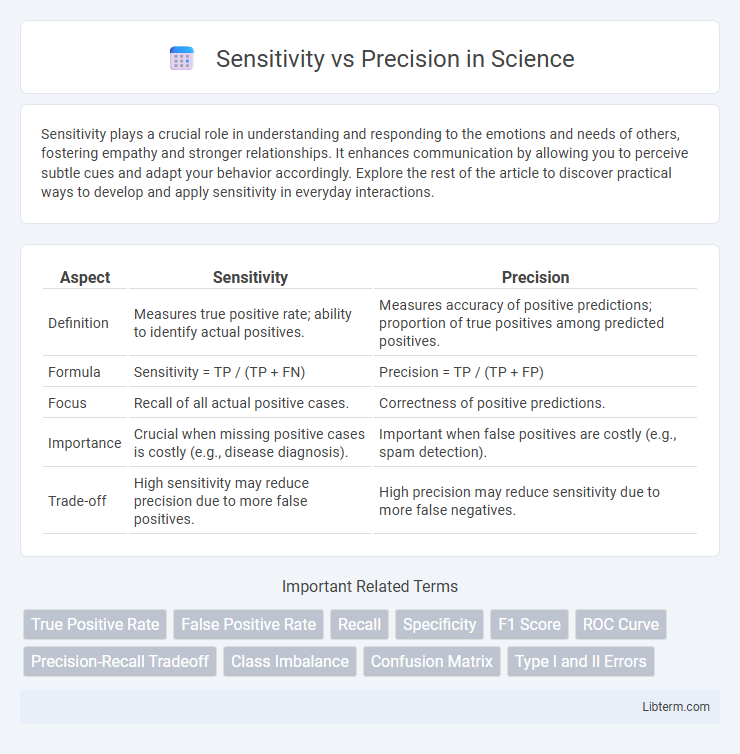Sensitivity plays a crucial role in understanding and responding to the emotions and needs of others, fostering empathy and stronger relationships. It enhances communication by allowing you to perceive subtle cues and adapt your behavior accordingly. Explore the rest of the article to discover practical ways to develop and apply sensitivity in everyday interactions.
Table of Comparison
| Aspect | Sensitivity | Precision |
|---|---|---|
| Definition | Measures true positive rate; ability to identify actual positives. | Measures accuracy of positive predictions; proportion of true positives among predicted positives. |
| Formula | Sensitivity = TP / (TP + FN) | Precision = TP / (TP + FP) |
| Focus | Recall of all actual positive cases. | Correctness of positive predictions. |
| Importance | Crucial when missing positive cases is costly (e.g., disease diagnosis). | Important when false positives are costly (e.g., spam detection). |
| Trade-off | High sensitivity may reduce precision due to more false positives. | High precision may reduce sensitivity due to more false negatives. |
Understanding Sensitivity and Precision
Sensitivity, also known as recall, measures the proportion of true positive cases correctly identified by a model, reflecting its ability to detect relevant instances. Precision quantifies the accuracy of positive predictions by calculating the ratio of true positives to all predicted positives, indicating the model's reliability in identifying relevant results. Understanding the balance between sensitivity and precision is crucial for optimizing model performance, especially in applications like medical diagnosis and fraud detection, where the cost of false negatives or false positives varies significantly.
Defining Sensitivity in Data Analysis
Sensitivity, also known as recall, measures the proportion of true positive results correctly identified by a data analysis model, reflecting its ability to detect relevant cases. It is calculated as the ratio of true positives to the sum of true positives and false negatives, emphasizing the model's effectiveness in minimizing missed detections. High sensitivity is crucial in contexts where overlooking positive instances can lead to significant consequences, such as medical diagnosis or fraud detection.
What is Precision?
Precision measures the accuracy of positive predictions by calculating the ratio of true positive results to the total number of positive predictions made (true positives plus false positives). It evaluates how many predicted positive cases are actually correct, which is crucial in scenarios where the cost of false positives is high. High precision indicates a low false positive rate, making it essential in fields like medical diagnostics and spam detection.
Key Differences Between Sensitivity and Precision
Sensitivity measures the proportion of true positives correctly identified by a test, reflecting its ability to detect actual positive cases. Precision evaluates the proportion of positive identifications that are truly correct, indicating the reliability of positive predictions. The key difference lies in sensitivity prioritizing capturing all positives, while precision emphasizes minimizing false positives.
Importance of Sensitivity in Real-World Applications
Sensitivity, also known as recall, measures the ability of a model to correctly identify true positives, making it crucial in applications such as medical diagnostics or fraud detection where missing a positive case can have severe consequences. High sensitivity ensures that fewer actual positive instances are overlooked, which is vital for early disease detection, enhancing patient outcomes, and preventing financial losses. Emphasizing sensitivity in real-world applications helps to prioritize safety and risk mitigation over the risk of false alarms.
When to Prioritize Precision Over Sensitivity
Prioritize precision over sensitivity when false positives carry a higher cost, such as in spam email filtering, where incorrectly marking legitimate emails as spam is more disruptive than missing some spam. High precision reduces the risk of unnecessary actions triggered by incorrect positive results, crucial in scenarios like medical diagnostics for rare diseases where false alarms can cause patient anxiety and unnecessary treatments. In fraud detection, prioritizing precision minimizes customer inconvenience from falsely flagged transactions, ensuring trust and operational efficiency.
Trade-offs: Balancing Sensitivity and Precision
Balancing sensitivity and precision involves a trade-off where increasing sensitivity typically reduces precision, leading to more false positives, while enhancing precision often decreases sensitivity, causing more false negatives. Optimizing this balance depends on the specific application context, such as medical diagnostics prioritizing sensitivity to detect all potential cases versus spam filters emphasizing precision to avoid misclassifying legitimate emails. Effective strategies include tuning classification thresholds, using cost-sensitive learning, or applying receiver operating characteristic (ROC) curves to identify an optimal trade-off point.
Measuring Sensitivity and Precision: Common Formulas
Sensitivity is measured using the formula True Positives divided by the sum of True Positives and False Negatives, reflecting the proportion of actual positives correctly identified. Precision is calculated as True Positives divided by the sum of True Positives and False Positives, indicating the accuracy of positive predictions. Both metrics are crucial in evaluating classification models, particularly in fields such as medical diagnostics and information retrieval.
Sensitivity vs Precision in Medical Diagnostics
Sensitivity measures a medical test's ability to correctly identify patients with a disease, minimizing false negatives, which is crucial for early diagnosis and treatment. Precision, or positive predictive value, indicates the proportion of true positive results among all positive calls, reflecting the test's reliability in confirming disease presence. Balancing high sensitivity with precision is essential in diagnostics to ensure accurate detection while reducing unnecessary treatments.
Best Practices for Optimizing Sensitivity and Precision
Maximizing sensitivity involves selecting models and thresholds that reduce false negatives, crucial in critical applications like medical diagnostics, while enhancing precision requires minimizing false positives to ensure reliability in tasks such as spam detection. Employing cross-validation techniques, balanced datasets, and appropriate metric tuning helps in aligning model performance with specific sensitivity and precision goals. Regularly updating models with real-world data and leveraging ensemble methods further optimize the trade-off between sensitivity and precision for targeted outcomes.
Sensitivity Infographic

 libterm.com
libterm.com